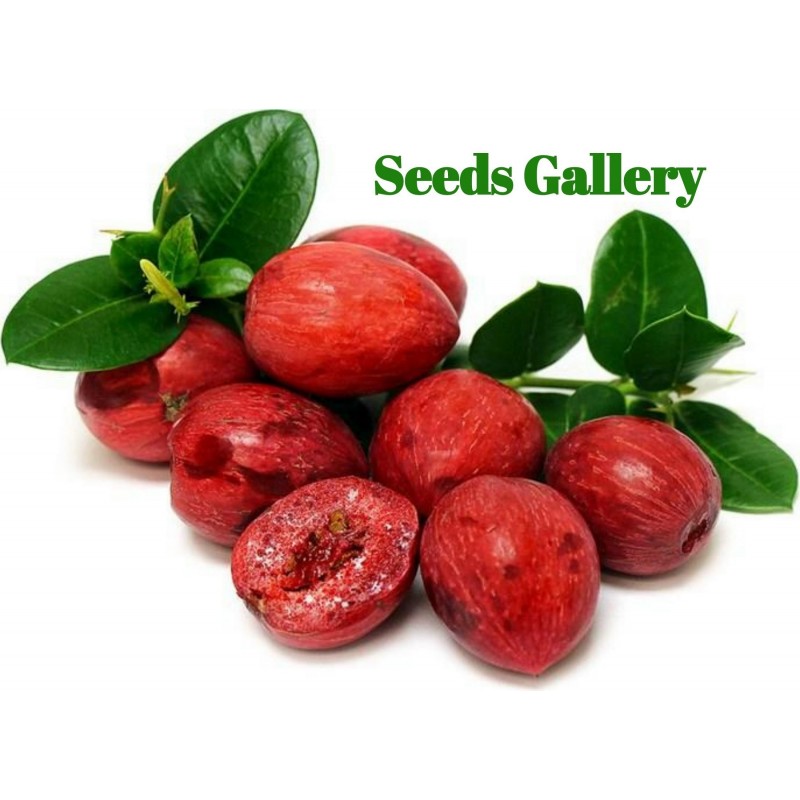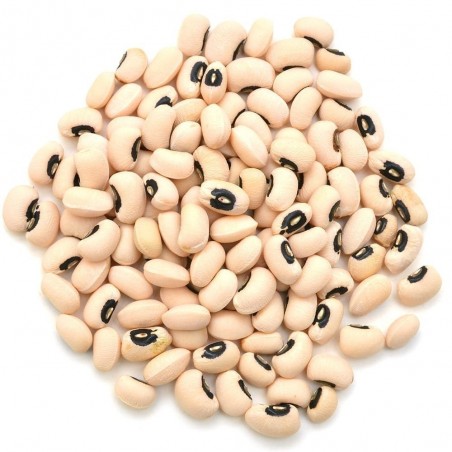
Natal Plum Seeds (Carissa macrocarpa)
Natal Plum Seeds (Carissa macrocarpa)
Price for Package of 3 seeds.
Medium-sized fruit up to 2+ inches long, with a very juicy red pulp. Usually used for making preserves. Medium-sized shrub up to 15ft high. Sometimes used for hedging or ground cover. Natal plum's can fruit and flower throughout the year. Flowers are bright white, with five narrow lobes, and have a wonderful fragrance.
Hardiness
Natal plum's are sub-tropical, surviving temperatures down to 25F when mature. Young plants should be protected from hard freezes.
Growing Environment
Plants are not too particular about soil or water requirements. Will stand short periods of drought and will not stand flooding. Grow in full sun (preferably) or light shade.
Propagation
By seed, or via budding and air-layering.
Uses
Eaten fresh or used to make preserves.
Native Range
Native to coastal South Africa.
Other Names: Hedgethorne
Zone: 9 to 11
Growth Rate: Moderate to Fast
Plant Type: Evergreen Shrub
Family: Apocynaceae
Native Range: South Africa
Height: 5 to 15 feet
Bloom Color: White
Sun: Full Sun
Fall Color: Evergreen
Drought Tolerance: Moderate
Water: Low
Maintenance: Moderate
Site Requirements /Soil Tolerances: Natal Plum does best in at least 4 hours of direct sunlight a day, night temperatures of 50 to 65° and day temperatures of 68° or higher. Due to the wide tolerance of soil types, it can be grown almost anywhere there is good drainage and sufficient light. A suitable compost for Natal plum consists of 2 parts loam to 1 part peat moss to 1 part sand.
Culture: Fertilize every 3 to 4 months. Trim Natal Plum anytime of the year. Seedlings may begin to produce fruit in 2 years.
Uses: Thorns make Natal Plum an excellent plant for barriers and is a good container specimen or bonsai.
Sowing Carissa grandiflora Seeds:
For best results, please follow the instructions in the order provided.
Scarify: Soak in water for 24 hours.
Stratify: None
Germination: Sow 1/4” Deep, Keep warm and Moist (Not wet).
For more information about seed pretreatment and growing trees and shrubs from seed, please try the following links:
http://www.forestry.gov.uk/pdf/fcpg018.pdf/$file/fcpg018.pdf
WIKIPEDIA:
Carissa macrocarpa (Natal Plum), is a shrub native to South Africa, where it is commonly called the Large Num-Num. In Zulu, as well as in the Bantu tribes of Uganda, it is called amatungulu. In Afrikaans the fruit is called Noem-Noem.
C. macrocarpa deals well with salt-laden winds, making it a good choice for coastal areas. It is commonly found in the coastal bush of the Eastern Cape and Natal.[1] It produces shiny, deep green leaves and snowy white flowers whose perfumed scent intensifies at night. Like other Carissa species, C. macrocarpa is a spiny, evergreen shrub containing latex. They bloom for months at a time. The ornamental plump, round, crimson fruit appears in summer and fall (autumn) at the same time as the blooms. In moderate, coastal areas the fruits appear through the year. The fruit can be eaten out of hand or made into pies, jams, jellies, and sauces.[1] Some claim that other than the fruit, the plant is poisonous.[2] However this claim is a myth, possibly based on similarities to other plants with milky sap.[3] The California Poison Control System rates the plant as mildly toxic.[4] It appears in the South African National tree list as number 640.3.
A traditional food plant in Africa, this little-known fruit has potential to improve nutrition, boost food security, foster rural development and support sustainable landcare.
Distribution
Carissa macrocarpa grows mainly in coastal areas in South Africa. It can be found on sand dunes and on the edges of coastal forests in Eastern Cape Province northwards from Natal to Mozambique. Today the plant is also growing commonly in southern Florida and is cultivated in southern California.
Propagation
Carissa macrocarpa is quite easy to grow. Its seeds germinate 2 to 4 weeks after sowing. The development of the seedlings is very slow at first. Plants cultivated from seeds are bearing fruits within the first 2 years. A vegetative propagation is possible and preferred. The most efficient method consists of notching young branchlets by cutting them halfway through. Then they are bent downwards and allowed to hang limply. After the young branchlets have built a callus, in approximately 2 months, the cutting has to be removed from the parent and planted in sand under moderate shade. Roots form within one month. Carissa macrocarpa will produce fruits within the first 2 years applying this reproduction method.
Fertilizing
The maintenance of Carissa macrocarpa is simple. The plant needs a standard, balanced fertilizer (equal amount of N, P, K) for successful fruit production.
Pollination
In the homeland of Carissa macrocarpa night-flying insects pollinates the white, bisexual flowers. Out of its origin area unfruitfulness has been attributed to inadequate pollination. However, hand pollination is possible and in future poor pollination could be avoided by cultivation of floral structures that are highly favourable for self-fertilization.
Orchard design
Narrow hedges are recommended as orchard design for Carissa macrocarpa due to its prickles. Like this the access to the fruits which are growing on the top of the bush is much simpler. Pruning the plant is beneficial because it induces the development of more fruiting tips. Beyond cutting, little pruning work has to be done to restrain the bush from massive growth. This results in an increasing amount of fruits per plant.
Harvesting
With a minimal yield of 3 tons per hectare under commercial production in South Africa, the productivity is considered as high. The main fruit production is in summer with slightly varying ripening times. So each fruit must be picked when it is ripe. Under good growing conditions the plant also produces many fruits during the off-season. During the harvest attention must be paid to the ripe fruits’ skin as it can be easily bruised and is highly perishable.
Cultivars for crop-production
Horticultural Scientists in South Africa and the USA (Florida and California) have selected and named several Carissa types which tend to produce fruits more reliably. The fruits are larger, have a good texture and contain less seeds. In California they selected Fancy (many large fruits with few seeds), Torrey Pines (good crop-production and abundant pollen), Frank (good pollen supplier but low yield), Chelsey and Serena. In Florida Gifford is one of the best fruit bearers. In Africa C. haematocarpa is defined suitable for drier areas and C. bispinosa for higher altitudes.
| Organic Seeds ? | Organic Seeds |
|---|---|
| Edible ? | Edible |
| Pretreatment of sowing ? | Soak in water before sowing 12-24 h |
| Sowing depth ? | Sowing depth 5 mm |
| Life Cycle: | Perennial plant : Yes |
| Resistant to cold and frost ? | Resistant to cold and frost : -3° C |
| Handpicked seeds ? | Handpicked seeds |
| Origin of seeds ? | Origin of Seeds: Spain |
| Medicinal Plant ? | Medicinal Plant: Yes |


Your review appreciation cannot be sent
Report comment
Report sent
Your report cannot be sent
Write your review
Review sent
Your review cannot be sent
🌍 Worldwide Shipping from the EU
We ship worldwide from the European Union using registered air post with signature confirmation on delivery.
📦 Tracking Your Order
Log in to your account and go to Order History > Details to find your tracking number.
You will receive email notifications at every step — please check your spam/junk folder if you don’t see them.
Track your package via:
⚠️ Important Notices
Cash on delivery is not available.
Always provide a valid mobile number with country code when ordering (e.g., +365 456 7686 576).
Do not order to P.O. Boxes or if you cannot be home to sign for the package. We cannot leave parcels with neighbors.
If a package sent to a P.O. Box is lost or undelivered, you lose the right to a refund.
📦 Lost, Returned & Reshipping Packages
For customers in Brazil and Mexico:
We cannot refund packages lost or destroyed by customs.
If your package is returned, we will refund only the product cost — shipping costs are not refundable.
You must pay return postage (€2) and any costs for reshipping.
If a package is returned to us for any reason, you are responsible for paying the return shipping (€2) plus the cost to resend the package.
🚚 Shipment Delivery
Registered shipments require a signature from the recipient.
If your tracking shows the package is still at the origin post office, it means the package is in transit — please contact your local post office directly for updates.
We are not responsible for delivery times and cannot track shipments for you.
📅 Delivery Options & Estimated Times
Delivery Option Processing Time Notes Priority Delivery Ships in 1-7 business days Prioritizes order processing (not guaranteed faster delivery); delays possible during holidays (3-10 days) Secured Delivery Ships in 1-7 business days Available for orders up to €150; refund if lost Standard Delivery Ships in 7-10 business days More economical; delays possible during holidays (7-14 days) Estimated Delivery Time:
Within the EU: 3–20 days
Worldwide: 5–30 days
Example delivery times to the USA:
Delivered in 13, 17, 19, 22, or 27 days.Note: Delivery times depend on your location and the local postal system. COVID-19 may cause additional delays.
💰 Shipping Costs
Shipping and handling fees are calculated automatically during checkout based on the weight of the parcel and the destination country.
⏰ Order Processing Hours
We do not process or ship orders on Saturdays or Sundays.
💳 Payment Options
Bank Transfer (SEPA / IBAN / SWIFT-BIC)
Include your order reference in the payment description (e.g., "SGS-19811702"). Orders without payment within 7 days are automatically cancelled.PayPal
Payments accepted in Euros only. Please select Euros at checkout.Card Payment
For card payments, visit our other site: Exotic Seeds Store
We accept Visa, MasterCard, American Express, CB, Diners Club, Discover, China UnionPay, JCB, and Discover.
⚠️ Transaction Fees
Customers are responsible for any transaction fees. Please provide payment details to help us process your order efficiently.
📢 Final Notes
Before placing your order, please check our website for any special notices, holiday schedules, or specific conditions that may affect your purchase.
Related Products

















